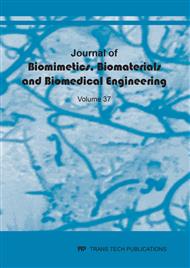[1]
V. Lun, W.H. Meeuwisse, P. Stergiou, and D. Stefanyshyn, Relation between running injury and static lower limb alignment in recreational runners, Br. J. Sports. Med. 38(2004)576-580.
DOI: 10.1136/bjsm.2003.005488
Google Scholar
[2]
D.C. Lee, A.G. Brellenthin, P.D. Thompson, X. Sui, I.M. Lee, and C.J. Lavie, Running as a Key Lifestyle Medicine for Longevity, Pr. Cardiovascr. Dis. 60(2017)45-55.
DOI: 10.1016/j.pcad.2017.03.005
Google Scholar
[3]
Q. Mei, Y. Gu, Z. Zheng, L. Yang, and J. Fernandez, Foot shape perceived comfortand plantar pressure characteristics during long-distance running, Footwear Sci. 9(2017)S20-S22.
DOI: 10.1080/19424280.2017.1313899
Google Scholar
[4]
R.N. van Gent, D. Siem, M.M. Van, A.G. van Os, S.M. Biermazeinstra, and B.W. Koes, Incidence and determinants of lower extremity running injuries in long distance runners: a systematic review, Br. J. Sports. Med. 41(2007)469-480.
DOI: 10.1136/bjsm.2006.033548
Google Scholar
[5]
J.E. Taunton, M.B. Ryan, D.B. Clement, D.C. Mckenzie, D.R. Lloydsmith, and B.D. Zumbo, A retrospective case-control analysis of 2002 running injuries, Br. J. Sports. Med. 36(2002)95-101.
DOI: 10.1136/bjsm.36.2.95
Google Scholar
[6]
A.I. Daoud, G.J. Geissler, F. Wang, J. Saretsky, Y.A. Daoud, and D.E. Lieberman, Foot strike and injury rates in endurance runners: a retrospective study, Med. Sci. Sports. Exerc. 44(2012)1325-1334.
DOI: 10.1249/mss.0b013e3182465115
Google Scholar
[7]
Y. Thijs, C.D. De, P. Roosen, and E. Witvrouw, Gait-related intrinsic risk factors for patellofemoral pain in novice recreational runners, Br. J. Sports. Med. 42(2008)466-471.
DOI: 10.1136/bjsm.2008.046649
Google Scholar
[8]
R.W. Willy and I.S. Davis, Kinematic and kinetic comparison of running in standard and minimalist shoes, Med. Sci. Sports. Exerc. 46(2014)318-323.
DOI: 10.1249/mss.0b013e3182a595d2
Google Scholar
[9]
E.B.L. Iii, K.S.B. Sackiriyas, and R.W. Swen, A comparison of the spatiotemporal parameters, kinematics, and biomechanics between shod, unshod, and minimally supported running as compared to walking, Phys. Ther. Sport. 12(2011)151-163.
DOI: 10.1016/j.ptsp.2011.09.004
Google Scholar
[10]
Q. Mei, J. Fernandez, W. Fu, N. Feng, and Y. Gu, A comparative biomechanical analysis of habitually unshod and shod runners based on a foot morphological difference, Hum. Mov. Sci. 42(2015)38-53.
DOI: 10.1016/j.humov.2015.04.007
Google Scholar
[11]
J.E. Taunton, M.B. Ryan, D.B. Clement, D.C. McKenzie, D.R. Lloyd-Smith, B.D Zumbo, A retrospective case-control analysis of 2002 running injuries, Br. J. sports. Med. 36(2002)95-101.
DOI: 10.1136/bjsm.36.2.95
Google Scholar
[12]
N.G.Z. Hesar, A.V. Ginckel, A. Cools, W. Peersman, P. Roosen, D.D. Clercq, and E. Witvrouw, A prospective study on gait-related intrinsic risk factors for lower leg overuse injuries, Br. J. Sports. Med. 43(2009)1057-1061.
DOI: 10.1136/bjsm.2008.055723
Google Scholar
[13]
A. Nagel, F. Fernholz, C. Kibele, and D. Rosenbaum, Long distance running increases plantar pressures beneath the metatarsal heads: A barefoot walking investigation of 200 marathon runners, Gait Posture. 27(2008)152-155.
DOI: 10.1016/j.gaitpost.2006.12.012
Google Scholar
[14]
G. Schlee, T. Milani, and K. Roemer, Plantar pressure distribution, rearfoot motion and ground reaction force after long distance running, Footwear Sci, 1(2009)129-134.
DOI: 10.1080/19424280903449375
Google Scholar
[15]
H. Che, B.M. Nigg, and J.D. Koning, Relationship between plantar pressure distribution under the foot and insole comfort, Clin. Biomech. 9(1994)335-341.
DOI: 10.1016/0268-0033(94)90062-0
Google Scholar
[16]
A.G. Schache, P.D. Blanch, D.A. Rath, T.V. Wrigley, R. Starr, and K.L. Bennell, A comparison of overground and treadmill running for measuring the three-dimensional kinematics of the lumbo-pelvic-hip complex, Clin. Biomech. 16(2001)667-680.
DOI: 10.1016/s0268-0033(01)00061-4
Google Scholar
[17]
P.O. Riley, J. Dicharry, J. Franz, C.U. Della, R.P. Wilder, and D.C. Kerrigan, A kinematics and kinetic comparison of overground and treadmill running, Med. Sci. Sports. Exerc. 40(2008)1093-1200.
DOI: 10.1249/mss.0b013e3181677530
Google Scholar
[18]
K.P. Clark, L.J. Ryan, and P.G. Weyand, A general relationship links gait mechanics and running ground reaction forces, J. Exp. Biol. 220(2016)247-258.
DOI: 10.1242/jeb.138057
Google Scholar
[19]
A.A. Zadpoor and A.A. Nikooyan, The relationship between lower-extremity stress fractures and the ground reaction force: a systematic review, Clin. Biomech. 26(2011)23-28.
DOI: 10.1016/j.clinbiomech.2010.08.005
Google Scholar
[20]
M.W. Van, H. Hlobil, and H.C. Kemper, Incidence, severity, aetiology and prevention of sports injuries. A review of concepts, Sports. Med. 14(1992)82-99.
DOI: 10.2165/00007256-199214020-00002
Google Scholar
[21]
B.M. Nigg and M. Bobbert, On the potential of various approaches in load analysis to reduce the frequency of sports injuries, J. Biomech. 23(1990)3-12.
DOI: 10.1016/0021-9290(90)90036-3
Google Scholar
[22]
P. Larson, E. Higgins, J. Kaminski, T. Decker, J. Preble, D. Lyons, K. McIntyre, and A. Normile, Foot strike patterns of recreational and sub-elite runners in a long-distance road race, J. Sports. Sci. 29(2011)1665-1673.
DOI: 10.1080/02640414.2011.610347
Google Scholar
[23]
Y. Feng, Y. Song, Y, The Categories of AFO and Its Effect on Patients With Foot Impair: A Systemic Review. Physical Activity and Health. 1(2017) 8–16.
DOI: 10.5334/paah.3
Google Scholar
[24]
T.L. Milani, E.M. Hennig, and M.A. Lafortune, Perceptual and biomechanical variables for running in identical shoe constructions with varying midsole hardness, Clin. Biomech. 12(1997)294-300.
DOI: 10.1016/s0268-0033(97)00008-9
Google Scholar
[25]
Y. Zhang, Y.D. Gu, G. Fekete, Review on biomechanical and epidemiological research on injuries from high heels, Journal of Ningbo University(NSEE). 30(2017)81-89.
Google Scholar


